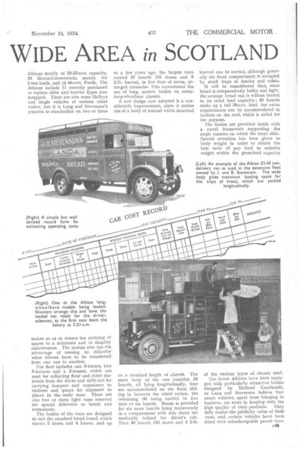WIDE AREA in SCOTLAND
Page 111

If you've noticed an error in this article please click here to report it so we can fix it.
Albions mostly of 30-35-cwt. capacity, 29 Morris-Commercials, mainly for 1-ton loads, and 15-30-cwt. Fords. The Albions include 11 recently purchased to replace older and heavier types now scrapped. There are also some Halleys and single vehicles of various other makes, but it is Lang and Stevenson's practice to standardize on two or three to a few years ago, the largest vans carried 35 boards (81 dozen and 8 2-1b. loaves), in five tiers of seven, arranged crosswise. This necessitated the use of long, narrow bodies on extralong-wheelbase chassis.
A new design now adopted is a considerable improvement, since it makes use of a body of normal width mounted loaves) can be carried, although generally the front compartment is occupied by small trays of fancies and cakes..
It will be remembered that, since bread is comparatively bulky and light, the average bread van is seldom loaded to its rated load capacity ; 40 boards make up a full 30-cwt. load, but extra requirements can be accommodated in baskets on the roof, which is railed for the purpose.
The bodies are provided inside with a metal framework supporting the angle runners on which the trays slide. Special attention has been given to body weight in order to obtain the best ratio of pay load to unladen weight within the gross-load capacity
(Left) An example of the Albion 33-40 cwt. delivery van as used in the extensive fleet owned by J. and B. Stevenson. The wide body gives maximum loading space for the trays of bread, which are packed
longitudinally.




















































































































































































